NCERT Solutions for Class 4 Maths Chapter 12 - Ticking Clock and Turning Calendar
| Table of contents |

|
| Page No. 175: (Let Us Do) |

|
| Page No. 176 |

|
| Page No. 177 (Let Us Explore) |

|
| Page No. 178 |

|
| Page No. 180 |

|
| Page No. 181 |

|
| Let Us Do |

|
| Page No. 183 |

|
| Let Us Check |

|
Page No. 175: (Let Us Do)
Q1: Notice the number of days in February in the years 2024 and 2025.
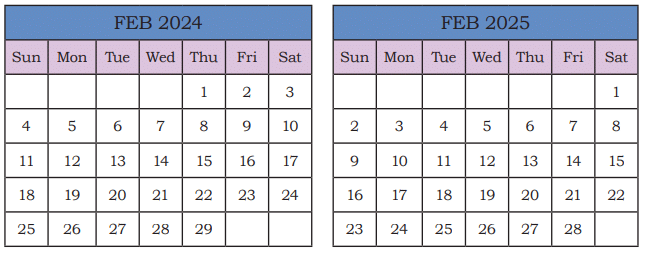
- Number of days in Feb 2024 = _____________
- Number of days in Feb 2025 = _____________
Ans:
- Number of days in Feb 2024 = 29 Days
- Number of days in Feb 2025 = 28 Days
Page No. 176
Q2: Fill in the blanks with consecutive leap years before and after 2024.
Ans: A leap year occurs every 4 years.
2016, 2020, 2024, 2028, 2032, 2036
Q3: We know that most years have 365 days. How many days would a leap year have?
Ans: Leap year: 365 + 1 = 366 days.
Q4: Write the names of the months when you celebrate your favourite festivals.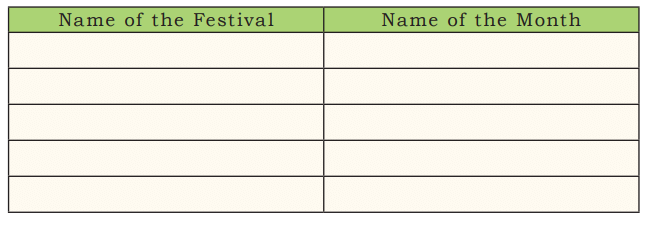 Ans: Example festivals:
Ans: Example festivals: 
Q5: Answer the following questions by writing the appropriate days of the week:
(a) Today: ___________
(b) Yesterday: ___________
(c) Tomorrow: ___________
(d) Day after tomorrow: ___________
(e) Day before yesterday: ___________
Ans: Assume today is Friday, April 25, 2025:
(a) Today: Friday
(b) Yesterday: Thursday
(c) Tomorrow: Saturday
(d) Day after tomorrow: Sunday
(e) Day before yesterday: Wednesday
Q6: July 1 is a Monday. Write the dates for the next two Mondays.
Ans: July 1: Monday.
Each day of a week comes exactly 7 days after the previous occurrence of the same weekday.
So, the dates for the next two Mondays will be
Next Monday: July 1 + 7 = July 8.
Following Monday: July 8 + 7 = July 15.
Q7: Laali is born on 04/07/2014 and Chotu is born on 04/12/2019. Who is older among the two and how much?
Ans: Laali: Born 04/07/2014.
Chotu: Born 04/12/2019.
Compare: 2014 < 2019, Laali is older.
Difference: From 04/07/2014 to 04/12/2019.
Years: 2019 − 2014 = 5 years.
Months: July to December = 5 months.
Days: Same day (4th), so 0 days.
Laali is older by 5 years, 5 months.
(a) Laali will turn 5 years old on ______________.
Ans: Born: 04/07/2014.
5 years old: 04/07/2014 + 5 years = 04/07/2019.
(b) Chotu's 10th birthday will be celebrated on
Ans: Born: 04/12/2019.
10th birthday: 04/12/2019 + 10 years = 04/12/2029.
Q8: Check the manufacturing and expiry dates on the wrapper of any biscuit packet.
(a) How old is the packet of biscuits?
Ans: Example: Manufacturing: 01/01/2025, Today: 25/04/2025.
Duration: From 01/01/2025 to 25/04/2025.
- Months: January to April = 3 months.
- Days: 31 (Jan) + 28 (Feb) + 31 (Mar) + 25 (Apr) − 1 = 114 days ≈ 3 months, 24 days.
- 3 months, 24 days.
(b) How many more days are the biscuits safe to eat?
Ans: Example: Expiry: 01/01/2026, Today: 25/04/2025.
Duration: From 25/04/2025 to 01/01/2026.
- Months: April 2025 to January 2026 = 8 months.
- Days: 5 (Apr) + 31 (May) + 30 (Jun) + 31 (Jul) + 31 (Aug) + 30 (Sep) + 31 (Oct) + 30 (Nov) + 31 (Dec) = 251 days ≈ 8 months, 11 days.
- 8 months, 11 days.
Q9: Notice the day on which July 15 falls in your calendar. Now find out what day is August 15? September 15? October 15? What pattern do you notice? Share in grade.
Ans: Assume July 15, 2024, is a Monday (calendar check).
August 15: 31 days later (July 15 to August 15).
31 ÷ 7 = 4 weeks, 3 days. Monday + 3 = Thursday.
September 15: 31 days later (August 15 to September 15).
Thursday + 3 = Sunday.
October 15: 30 days later (September 15 to October 15).
30 ÷ 7 = 4 weeks, 2 days. Sunday + 2 = Tuesday.
Pattern: Days shift by 2–3 days per month (30–31 days).
Now choose a date and look up the day on which it falls. Challenge your friends to guess what day will the same date fall in the following month.
Ans: Do it Yourself!
Page No. 177 (Let Us Explore)
Q1: Find out when the year begins in each of these calendars.
Ans:
Hindu Calendar – Starts with Chaitra (March/April)
Islamic Calendar – Starts with Muharram (Moves each year; in 2025, it starts in July/August)
Sikh Calendar (Nanakshahi) – Starts with Chet (March/April)
Q2: Check how the names of the months in these calendars correspond to the months in the English calendar.
Ans:
Hindu Calendar:
Chaitra ≈ March/April
Vaishakha ≈ April/May
And so on...
Islamic Calendar:
Muharram, Safar, etc.
These months move about 10 days earlier every year because it follows the moon.
Sikh Calendar:
Chet ≈ March/April
Vaisakh ≈ April/May
And so on...
Q3: Identify the months from the Hindu/Islamic/Sikh or any other calendar in which some of the important festivals of the community fall.
Ans: Hindu Festivals:
Diwali – Kartika (October/November)
Holi – Phalguna (February/March)
Islamic Festivals:
Eid al-Fitr – Shawwal (April/May in 2025)
Eid al-Adha – Dhu al-Hijjah (June/July in 2025)
Sikh Festivals:
Vaisakhi – Vaisakh (April)
Guru Nanak Jayanti – Kartik (November)
Q4: Identify the dates of the new moon and full moon in your community's calendar every month. Do you notice any pattern?
Ans: In the Hindu calendar,
Purnima means full moon
Amavasya means new moon
These come about 15 days apart
In the Islamic calendar,
The new moon marks the start of a new month
The lunar cycle (from new moon to next new moon) is about 29.5 days, so there is a clear pattern.
Q5: How are the full moon or new moon days named in your community's calendar?
Ans: Hindu Calendar:
Purnima – Full Moon
Amavasya – New Moon
Islamic Calendar:
The new moon starts each month (e.g., 1st Muharram)
Sikh Calendar:
The new month begins on Sangrand
Special days like full moons are observed during religious occasions
Page No. 178
Look at the picture below. It shows the time spent on different activities by a doctor. Write the number of hours spent on each activity in the space provided. Then, find the total number of hours between 6 o'clock morning to 6 o'clock evening and 6 o'clock morning of the next day.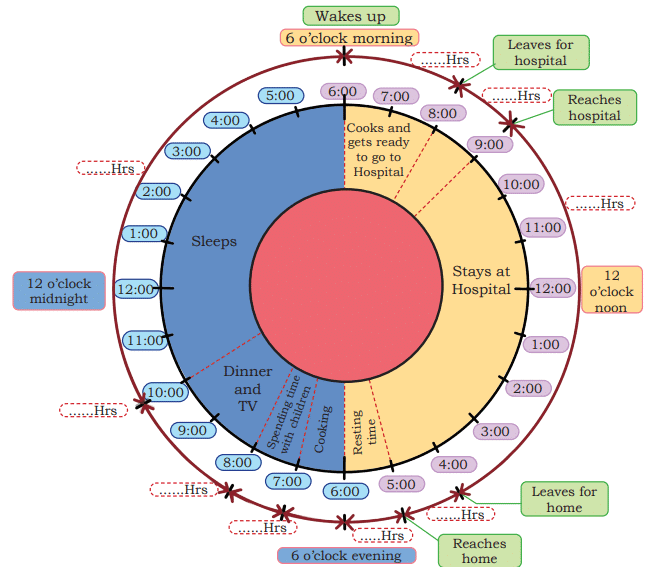 The total number of hours is ________ .
The total number of hours is ________ .
Ans: 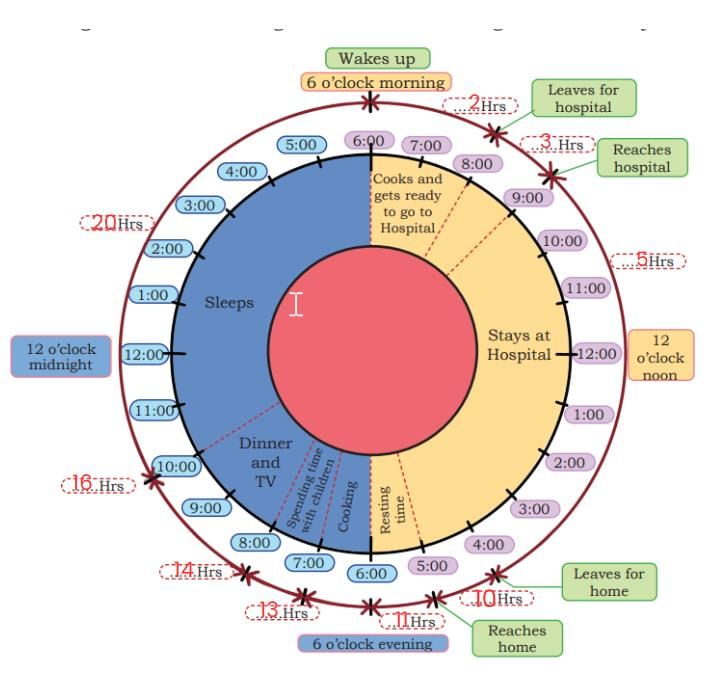
- Total: 6 AM to 6 PM = 12 hours.
- Full day: 6 AM to next 6 AM = 24 hours.
Page No. 180
Fill in the blanks by writing time in the appropriate format.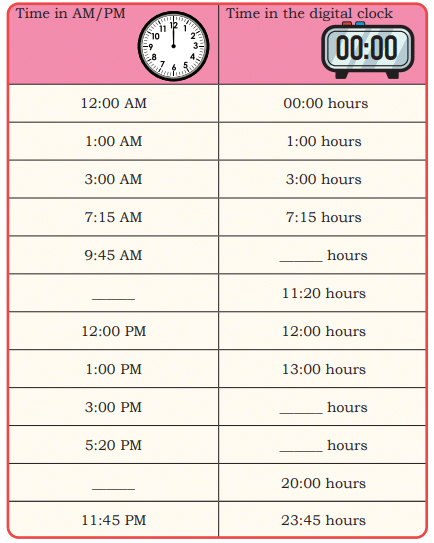 Ans:
Ans: 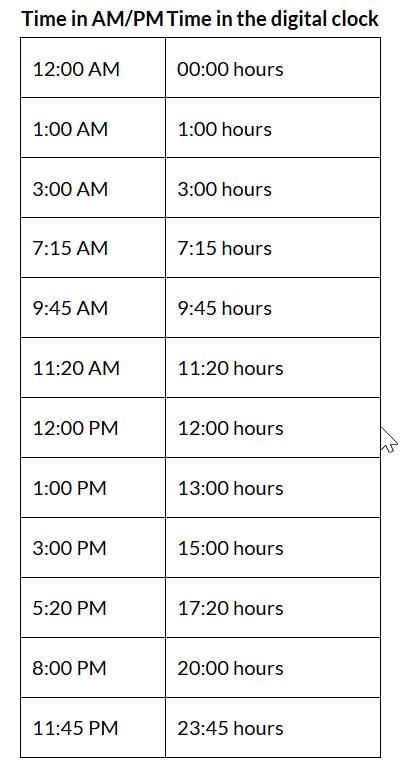
Page No. 181
Raghav leaves home at 8:20 AM and returns back at 8:35 AM. How much time has he taken?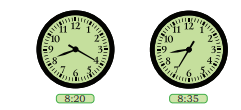 Ans: From 8:20 AM to 8:35 AM.
Ans: From 8:20 AM to 8:35 AM.
Minutes: 35 − 20 = 15 minutes.
Let Us Do
Q1: Show the appropriate times on the clock as per instructions.
(a) Raghav started doing his homework at 10:20 AM. He took 25 minutes to finish it. Show the time that he finished his homework. Ans:
Ans: 
- Start: 10:20 AM.
- Add 25 minutes: 10:20 + 20 = 10:40, +5 = 10:45 AM.
- Ans: 10:45 AM.
(b) Muneera starts reading a story at 4:15 PM. She finishes reading it in 45 minutes. Show the time that she finished reading the story. Ans:
Ans: 
- Start: 4:15 PM.
- Add 45 minutes: 4:15 + 45 = 4:60 = 5:00 PM.
- Ans: 5:00 PM.
(c) Akira leaves for school at 8:00 AM. She reaches school in 15 minutes.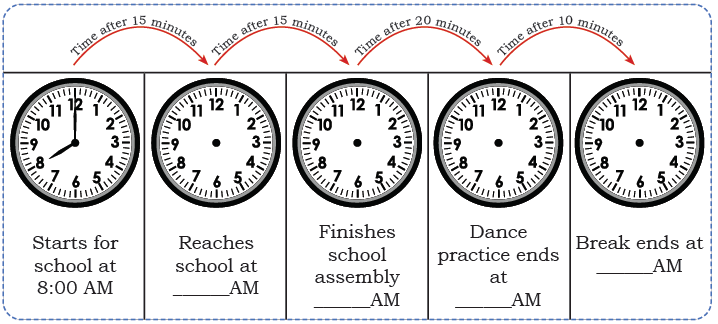 Ans:
Ans: 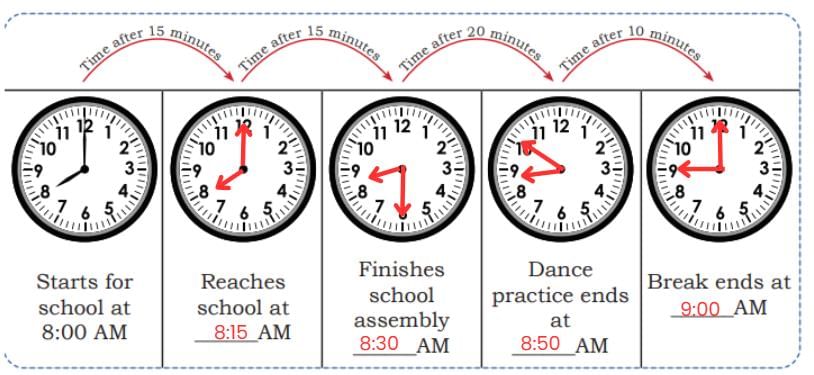

(d) Who do you think is correct? Is there any relation between 1 hour and 60 minutes?
Ans: Both are right!
Akira says she spent 1 hour (from 8:00 to 9:00).
The other person says 60 minutes.
As,
1 hour = 60 minutes
Observe the shaded portions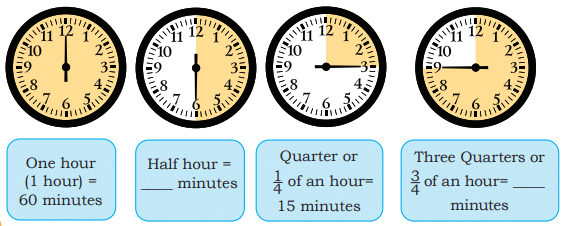 Ans:
Ans: 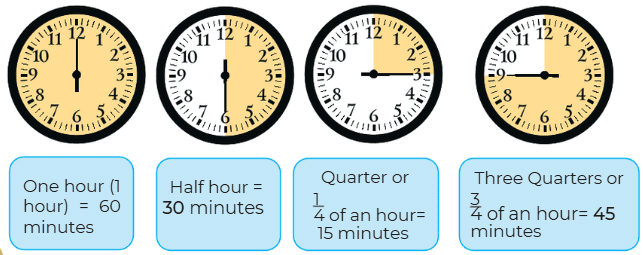
Page No. 183
Q: Find out how much time you take to
(a) boil milk
Ans: Example: Boiling milk takes ~10 minutes.
(b) fill water from tap in a bucket
Ans: Example: Filling a bucket takes ~10 minutes.
Q: What activities can you do in 5 minutes?
Ans: Examples: Brush teeth, tie shoes, eat a snack, read a page.
Let Us Check
Three friends read time from a clock. Who is right? Discuss the error and explain how one reads the clock correctly.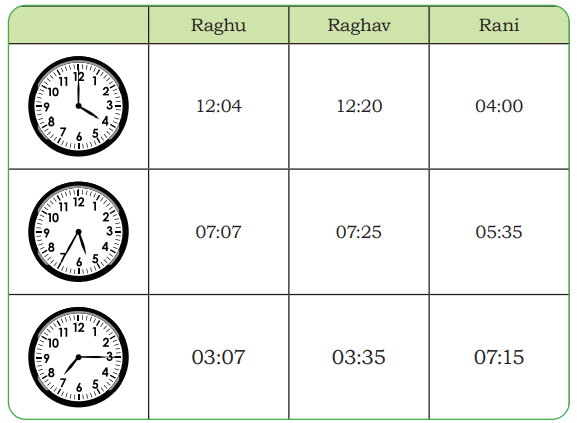 Ans: First Row: Big Hand at 12, Small Hand at 4
Ans: First Row: Big Hand at 12, Small Hand at 4
Correct Time: 04:00
Rani is correct.
Second Row: Big Hand at 7, Small Hand at between 5 and 6
- Correct Time: 05:35
Rani is correct.
Third Row: Big Hand at 3, Small Hand at 7
- Correct Time: 07:15
Rani is correct.
|
54 videos|186 docs|14 tests
|
FAQs on NCERT Solutions for Class 4 Maths Chapter 12 - Ticking Clock and Turning Calendar
| 1. What is the significance of learning about clocks and calendars in Class 4? |  |
| 2. How do clocks and calendars help us in our daily activities? |  |
| 3. What are some key features of a clock that students should know? |  |
| 4. Why is it important to understand leap years when studying calendars? |  |
| 5. How can teachers make learning about clocks and calendars more engaging for students? |  |















